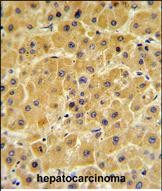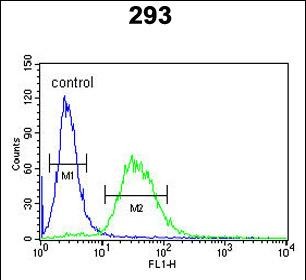F10 Antibody (C-term)
Purified Rabbit Polyclonal Antibody (Pab)
- SPECIFICATION
- CITATIONS
- PROTOCOLS
- BACKGROUND

Application
| FC, IHC-P, WB, E |
|---|---|
| Primary Accession | P00742 |
| Reactivity | Human |
| Host | Rabbit |
| Clonality | Polyclonal |
| Isotype | Rabbit IgG |
| Calculated MW | 54732 Da |
| Antigen Region | 351-381 aa |
| Gene ID | 2159 |
|---|---|
| Other Names | Coagulation factor X, Stuart factor, Stuart-Prower factor, Factor X light chain, Factor X heavy chain, Activated factor Xa heavy chain, F10 |
| Target/Specificity | This F10 antibody is generated from rabbits immunized with a KLH conjugated synthetic peptide between 351-381 amino acids from the C-terminal region of human F10. |
| Dilution | FC~~1:10~50 IHC-P~~1:50~100 WB~~1:1000 E~~Use at an assay dependent concentration. |
| Format | Purified polyclonal antibody supplied in PBS with 0.09% (W/V) sodium azide. This antibody is prepared by Saturated Ammonium Sulfate (SAS) precipitation followed by dialysis against PBS. |
| Storage | Maintain refrigerated at 2-8°C for up to 2 weeks. For long term storage store at -20°C in small aliquots to prevent freeze-thaw cycles. |
| Precautions | F10 Antibody (C-term) is for research use only and not for use in diagnostic or therapeutic procedures. |
| Name | F10 |
|---|---|
| Function | Factor Xa is a vitamin K-dependent glycoprotein that converts prothrombin to thrombin in the presence of factor Va, calcium and phospholipid during blood clotting (PubMed:22409427). Factor Xa activates pro-inflammatory signaling pathways in a protease-activated receptor (PAR)-dependent manner (PubMed:24041930, PubMed:30568593, PubMed:34831181, PubMed:18202198). Up-regulates expression of protease- activated receptors (PARs) F2R, F2RL1 and F2RL2 in dermal microvascular endothelial cells (PubMed:35738824). Triggers the production of pro- inflammatory cytokines, such as MCP-1/CCL2 and IL6, in cardiac fibroblasts and umbilical vein endothelial cells in PAR-1/F2R-dependent manner (PubMed:30568593, PubMed:34831181). Triggers the production of pro-inflammatory cytokines, such as MCP-1/CCL2, IL6, TNF-alpha/TNF, IL- 1beta/IL1B, IL8/CXCL8 and IL18, in endothelial cells and atrial tissues (PubMed:24041930, PubMed:35738824, PubMed:9780208). Induces expression of adhesion molecules, such as ICAM1, VCAM1 and SELE, in endothelial cells and atrial tissues (PubMed:24041930, PubMed:35738824, PubMed:9780208). Increases expression of phosphorylated ERK1/2 in dermal microvascular endothelial cells and atrial tissues (PubMed:24041930, PubMed:35738824). Triggers activation of the transcription factor NF-kappa-B in dermal microvascular endothelial cells and atrial tissues (PubMed:24041930, PubMed:35738824). Activates pro-inflammatory and pro-fibrotic responses in dermal fibroblasts and enhances wound healing probably via PAR-2/F2RL1-dependent mechanism (PubMed:18202198). Activates barrier protective signaling responses in endothelial cells in PAR-2/F2RL1-dependent manner; the activity depends on the cleavage of PAR-2/F2RL1 by factor Xa (PubMed:22409427). Up- regulates expression of plasminogen activator inhibitor 1 (SERPINE1) in atrial tissues (PubMed:24041930). |
| Cellular Location | Secreted. |
| Tissue Location | Plasma; synthesized in the liver. |

Thousands of laboratories across the world have published research that depended on the performance of antibodies from Abcepta to advance their research. Check out links to articles that cite our products in major peer-reviewed journals, organized by research category.
info@abcepta.com, and receive a free "I Love Antibodies" mug.
Provided below are standard protocols that you may find useful for product applications.
Background
F10 is the vitamin K-dependent coagulation factor X of the blood coagulation cascade. This factor undergoes multiple processing steps before its preproprotein is converted to a mature two-chain form by the excision of the tripeptide RKR. Two chains of the factor are held together by 1 or more disulfide bonds; the light chain contains 2 EGF-like domains, while the heavy chain contains the catalytic domain which is structurally homologous to those of the other hemostatic serine proteases. The mature factor is activated by the cleavage of the activation peptide by factor IXa (in the intrisic pathway), or by factor VIIa (in the extrinsic pathway). The activated factor then converts prothrombin to thrombin in the presence of factor Va, Ca+2, and phospholipid during blood clotting.
References
Alba,R., Blood 114 (5), 965-971 (2009)
Borensztajn,K., Thromb. Res. 124 (2), 219-225 (2009)
Larson,P.J., Biochemistry 37 (14), 5029-5038 (1998)
If you have used an Abcepta product and would like to share how it has performed, please click on the "Submit Review" button and provide the requested information. Our staff will examine and post your review and contact you if needed.
If you have any additional inquiries please email technical services at tech@abcepta.com.













 Foundational characteristics of cancer include proliferation, angiogenesis, migration, evasion of apoptosis, and cellular immortality. Find key markers for these cellular processes and antibodies to detect them.
Foundational characteristics of cancer include proliferation, angiogenesis, migration, evasion of apoptosis, and cellular immortality. Find key markers for these cellular processes and antibodies to detect them. The SUMOplot™ Analysis Program predicts and scores sumoylation sites in your protein. SUMOylation is a post-translational modification involved in various cellular processes, such as nuclear-cytosolic transport, transcriptional regulation, apoptosis, protein stability, response to stress, and progression through the cell cycle.
The SUMOplot™ Analysis Program predicts and scores sumoylation sites in your protein. SUMOylation is a post-translational modification involved in various cellular processes, such as nuclear-cytosolic transport, transcriptional regulation, apoptosis, protein stability, response to stress, and progression through the cell cycle. The Autophagy Receptor Motif Plotter predicts and scores autophagy receptor binding sites in your protein. Identifying proteins connected to this pathway is critical to understanding the role of autophagy in physiological as well as pathological processes such as development, differentiation, neurodegenerative diseases, stress, infection, and cancer.
The Autophagy Receptor Motif Plotter predicts and scores autophagy receptor binding sites in your protein. Identifying proteins connected to this pathway is critical to understanding the role of autophagy in physiological as well as pathological processes such as development, differentiation, neurodegenerative diseases, stress, infection, and cancer.




